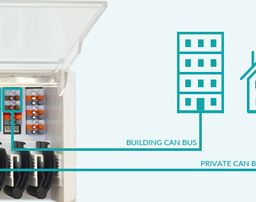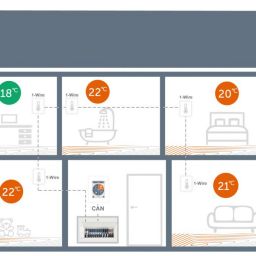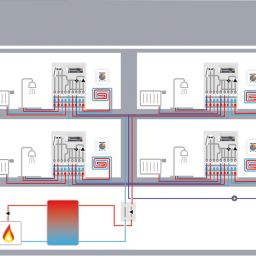The Indoor Air Quality Index IAQ in HVAC Applications
Reading time: 6 Min

The awareness of the importance of indoor air quality has increased significantly in recent years, both for the benefit of human well-being and for the preservation of the building fabric.
CO2 measuring devices have experienced a real boom since the correlation between the CO2 concentration and the aerosol content of indoor air became known. The covid pandemic has made the general public painfully aware of the role of aerosols and at the same time brought the impact of indoor air on our health into the public consciousness.
In fact, we humans supply our bodies with 9-18 m³ of indoor air every day – a mass about 10 times higher than that from food.[1]. Poor indoor air thus reduces our well-being in many ways:
- Irritation of the respiratory tract and eyes
- Sensory disturbances such as headaches, mood swings or loss of appetite
- Formation or intensification of allergies and hypersensitivities
- Possibly even an increased risk of cancer, e.g. due to chemicals from building materials or tobacco smoke.
Since science (and large parts of the HVAC industry) have long been aware of these correlations, the WHO coined the term “sick building syndrome” in the 1980s. Since indoor air quality not only affects the body and well-being of individuals, but also their performance, indoor air quality is also highly relevant for schools, offices and administration.
How strongly indoor air influences our performance
In 2015, a Harvard study impressively demonstrated the performance-reducing effect of VOCs (Volatile Organic Compounds). The volunteers were subjected to various cognitive disciplines after spending time in environments with varying levels of VOCs. A high VOC concentration was induced by materials commonly used in offices to create a realistic scenario. Neither the test persons nor the analysts had knowledge of the respective group membership of the participants (“double-blind test”).
The performance of the test subjects in the “green” building was an impressive 61% higher than that of the “non-green” building. With the additional use of a high-performance ventilation system, the performance advantage even doubled. In some cognitive disciplines, such as information processing and strategic thinking, the scientists even reported a 300% better performance rating [2].
The growing importance of indoor air quality also offers a great opportunity for the HVAC industry to incorporate this topic into its own creative sphere at an early stage. With forward-looking product management, interesting product concepts can already be designed today that stand out from the competition.
Two sensory principles for determining indoor air quality
While the focus is on the energy-efficient regulation of temperature and humidity for the prevention of moisture damage in heating and cooling applications, the CO2 indoor air concentration, measured in ppm (parts per million), is considered a particularly decisive criterion for the evaluation of healthy indoor air.
Where a highly accurate measurement of the CO2 concentration is mandatory or prescribed by building regulations, spectroscopically measuring NDIR sensors (Non-Dispersive Infrared) are used. These are very precise, but just as expensive.
So-called VOC sensors take a different approach. They measure the total concentration of volatile organic compounds (VOCs) and do not allow any statement about individual specific components or compounds. Unlike an NDIR CO2 sensor, for example, a VOC sensor cannot indicate the specific ventilation rate required, but only the VOC content in the air and thus a general change in the concentration of pollutants.
But why, despite their described limitations, are they ideally suited for the purpose of monitoring and maintaining healthy indoor air quality (IAQ)?
VOC sensors for measuring indoor air quality
Volatile organic compounds are released as gases from certain solids or liquids. Volatile organic compounds include a variety of chemicals emitted from a wide range of products.
Examples include: Paints and varnishes, cleaning agents, building materials and furniture, office equipment such as copiers and printers, graphic and craft materials such as glues and adhesives, and a variety of common household items up to children’s toys. Human emissions as well as emissions caused by everyday actions such as exhalation, perspiration, cooking or food consumption can also be detected.
What do VOC sensors detect?
- CO, CH4, liquid gas
- Alcohols
- Ketones
- Organic Acids
- Amines
- Aliphatic hydrocarbons
- Aromatic hydrocarbons
This illustrates a major advantage of this technology: VOC sensors detect a broad spectrum of gases that contribute to indoor air quality and can simultaneously derive a CO2 equivalent in ppm from this. A CO2 sensor, on the other hand, cannot do the reverse. VOC sensors therefore offer a more complete view of indoor air quality and are usually the more cost-effective solution.
They aggregate the readings of the different VOCs into an Index of Air Quality to indicate air quality in a single metric. According to the classification defined by the EPA (United States Environmental Protection Agency), it can be interpreted and visualised using a standardised colour code. Analogously, there is a classification based on the CO2 concentration in the indoor air.
The EPA’s TEAM (Total Exposure Assessment Methodology) studies have found that concentrations of about a dozen common organic pollutants are two to five times higher inside homes than outside. This is true whether the homes are in rural or highly industrialised areas.
Further TEAM studies suggest that people can expose themselves and others to very high levels of pollutants when using products containing organic chemicals. In addition, the elevated concentrations may be present in the air long after the activity has ended.
Room air sensors with algorithmic intelligence
The number of manufacturers of highly integrated VOC sensors is manageable. It is therefore not surprising that in the multitude of room air monitoring devices now available, sensors from the same manufacturers are doing their job. By integrating several sensors on one chip, they can now measure room temperature, relative humidity and air pressure with sufficient accuracy in addition to detecting volatile organic compounds.
Via simple interfaces, the raw values can be made available to a microcontroller and thus cleverly processed further. Through intelligent algorithms, the sensor can be automatically calibrated to its respective working environment and thus provide a more stable assessment of air quality appropriate to its place of use – regardless of whether it is installed in a kitchen, a living room or a warehouse.
Use cases for the HVAC industry
The number of products for room air monitoring, which has increased dramatically in the course of the Corona pandemic, is usually aimed purely at displaying the room air quality (IAQ) or CO2 concentration. Depending on the equipment, these can be operated with adjustable warning thresholds and corresponding visual and/or acoustic alarms.
If critical limit values are exceeded, it is time for an air exchange through classical window ventilation (shock ventilation). Even the last “ventilation slacker” is clearly made aware of the necessity and effectiveness of regular ventilation when looking at the development of the IAQ index or the CO2 concentration.
Selling indoor air monitoring equipment is certainly lucrative, albeit competitive. For manufacturers in the heating, ventilation and air conditioning (HVAC) industry, it could be a clever alternative to integrate the functionality into their systems and market it as a differentiating feature.
Application example of an integrated air quality sensor: °C-Lite room thermostat for surface heating. Left: Standby mode with colour indication of IAQ. Right: Detailed view of the sensor values
In addition to monitoring, CO2 and/or the Index for Air Quality can also be integrated into the control loop for a wide range of HVAC applications. It is conceivable, for example, to integrate them into a sensor and control element for decentralised ventilation systems such as fan coils, which can provide automated and energy-saving residential ventilation based on the IAQ index.
A compilation of further examples for the use of air quality sensors in HVAC applications such as room thermostats, heat pumps or boilers, ventilation systems, surface heating and much more can also be found here.













